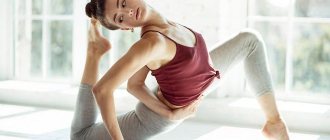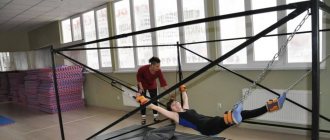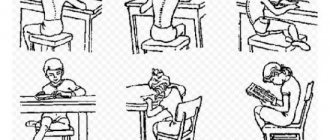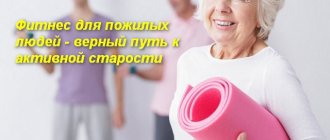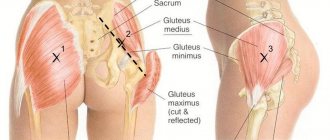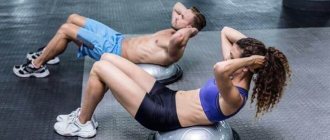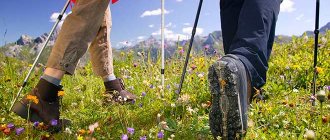Correct posture not only makes a person’s gait more attractive, but also indicates fully developed and healthy muscles and joints. Slouching, on the contrary, is an indicator that a person has certain problems. This flaw significantly spoils the external impression and self-esteem, and is a sign that the joints and muscles are poorly developed. Special exercises that are combined into complexes and can be performed at home can correct stooping in adulthood.
Strong and confident people have a special body position. They move, stand and sit completely differently. The reason for this is ideal posture, in which the head is raised high and the chest is straightened. This body position tells others about a person’s readiness to overcome absolutely any goal and has a positive effect on all aspects of life. Many people dream of becoming the same, but not everyone is moving in the right direction. If you're tired of constantly slouching and feeling insecure, it's time to change the situation. The main thing is to set a goal and choose the most effective and time-tested techniques that allow you to correct and correct your posture.
Getting rid of slouching not only improves self-esteem, but also has a positive effect on your own well-being and health. Age-related deterioration of posture is directly related to an imbalance of ligaments and muscle fibers responsible for correct body position. This manifests itself not only externally, but also over time causes a number of problems with the health of the musculoskeletal system and the following negative consequences, which manifest themselves in the form of:
- chronic pain in the cervical and spinal regions, as well as in the shoulder girdle;
- injuries to the knee joints, feet, hips and, of course, back;
- headaches and fatigue;
- muscle weakness and atrophy;
- digestive and respiratory system disorders;
- tight mobility;
- carpal tunnel syndrome;
- sciatica - sciatic neuralgia;
- compression and pinching of the nerve.
It is possible to correct your posture and stop hunching over as an adult. The main thing is not to let the situation get worse and start taking action. Having an idea of what correct posture looks like, you can easily determine deviations from the norm and select a set of exercises that allows you to correct and adjust your stoop. Thanks to correct posture, the body position will become correct, and, therefore, the muscles will function properly, becoming stronger. This will help you avoid problems with the musculoskeletal system, reduce the risks of injury and the development of chronic pain, and also change your appearance and well-being for the better.
Correcting body position
Correcting stoop requires first identifying the cause of the problem. Posture is most often crooked due to weakening of the muscles that hold the joints in place. In other words, some muscle groups are too tense, while others, on the contrary, are overly relaxed or weak, that is, they do not receive any load for a long time and become undeveloped.
Slouching in people who slouch is caused by the pectoral muscles being too tight. The result of this is that the shoulders are pulled forward and shifted toward the center. If a person also has a poorly developed back, an imbalance occurs, which results in a displacement of the shoulder girdle from the normal position. The muscular system is designed in such a way that it tries to compensate for any deviations from the norm. Weak activity of some leads to overexertion of others, which causes a feeling of increased discomfort and rapid fatigue.
Imbalance, as you can already understand, is the most common cause of stoop. To bring the muscles to a normal position and not have problems with posture even in old age, it is necessary to work on strengthening the low-active ones and stretching the over-active ones.
HOW TO CORRECT SLUPPING. Exercises for the back. MUSCLE CORSET FOR POSTURE
Buy your child a comfortable bed and a corset
Buy your child an orthopedic mattress and choose a back corrector.
Choose a corrector made from breathable fabric with elastic plates. It provides relief to the muscle corset and vertebrae. It is not recommended to wear this correction item for a long time, so as not to weaken the back muscles.
Corsets are convenient, but it’s better to take your son or daughter on some fun exercises and swimming.
How to independently assess your posture and identify existing problems?
Not all people pay enough attention to their posture. Many people don't even realize how twisted it is. To get rid of doubts and identify the presence or absence of a need for posture correction, you should first perform a small test. It's not complicated. It can be easily made at home.
You must wear tight clothing. This is done so that any deviations can be seen. Shoes are not worn on feet. They stand barefoot on the floor, but do not try to give the body perfect evenness. You should take the most comfortable position for yourself. For the purity of the “experiment”, it is recommended to close your eyes and walk a little in one place. This way, the feet will stand in their usual natural position. Next, they stop and take photographs from the front, back and side. You need to ask one of your friends or household members to take pictures.
The ideal posture shown in the photograph implies that the shoulder joints and ears are on the same line, the ribs are located above the hips, and this, in turn, is above the heels. The spine and pelvis should be in a neutral position. If, looking at your photographs, it is clear that the body position is exactly like this, then there are no problems with posture. In other cases, you will have to conduct an independent assessment of the existing defects.
Other tips for improving your posture.
However, good posture is more than just a few exercises. You must keep it constantly using these simple techniques:
- Remind yourself not to slouch.
- Imagine that you are being pulled towards the ceiling by a string from the top of your head.
- Strengthen your abs.
- Make sure your monitor is at face level when using your computer.
- Try a standing desk.
- Use ergonomic office furniture or sit on an exercise ball.
- Get up to walk and stretch throughout the day.
- Use stickers and use your phone to remind you about posture.
- Avoid sleeping on your stomach and use suitable pillows and comfortable mattresses.
PS Be patient and consistent, and your efforts to correct your posture will quickly pay off.
source
Basic assessment of postural deviations
Uneven body position indicates certain problems. To determine a specific postural deviation, you need to understand this issue much deeper. If you identify the specific cause of stoop, this will allow you to choose the most effective exercise that will get rid of the curvature.
Deviation 1: Slouched back and leaning backwards
This position is characterized by the emphasis of the hips forward when they protrude above the line of the ribs.
Problematic overactive muscles : thighs, erector spinae, gluteus medius and maximus, lower back and buttocks.
To stretch these muscle groups, do:
- runners stretching;
- “the best stretch in the world,” which involves stretching the buttocks while sitting;
- twists from a lying position;
- hamstring stretches;
- releasing the hamstrings using a massage roller.
Problematic inactive muscle groups: rectus femoris, which includes flexors and lower abs, external oblique, iliopsoas.
These muscles are activated by:
- hanging leg raises;
- "scissors";
- folding on a fitball;
- “Cocoon” twists.
Accordingly, by activating the sedentary ones and stretching the overactive ones, you can get rid of a slouched back.
Deviation 2: Lower cross syndrome
Characterized by a forward tilted pelvis and excessive deflection in the lumbar region.
Lower cross syndrome. Testing, diagnostics, work with muscle tone
The overactive muscles involved are: erector spinae, lumboiliac.
Stretched by:
- “pyramids” on a fitball;
- knee lunges performed on the floor;
- quadriceps stretching;
- pulling the knees to the chest from a lying position;
- self-massage of the quadriceps.
Among the inactive muscles, the ones responsible for correct position are the gluteus maximus and the abdominal press.
They are activated when running:
- crunches with legs raised;
- gluteal bridge (regular and on one leg), as well as on a fitball;
- pull-ups from a lying position in a “frog” position.
Deviation 3: Rounded shoulders
This deviation is manifested by excessive protrusion of the shoulders beyond the line of the ears.
The overactive muscles in this case include the pectoralis minor and pectoralis major.
The following exercises allow you to stretch these muscles:
- stretching the anterior deltoid;
- moving the elbows back;
- stretching the deltas in a sitting position;
- dynamic stretching for the chest;
- stretching the pectoral muscle groups on a fitball.
Low-active muscles are: rotator cuff, lower trapezius, serratus anterior.
Strengthen these muscles by doing:
- arm abductions with a tape back;
- external rotation of the shoulder girdle;
- traction for the rear deltas and on a low block.
Deviation 4: Forward head
The ears extend beyond the line of the shoulder girdle.
Overactive muscles: levator scapula, which is located on the back of the neck and is responsible for tilting the head back, upper trapezius, neck extensors.
Exercises for stretching overactive muscles:
- myofascial release (self-massage) of the neck;
- pulling the chin to the chest;
- stretching the pectoral, clavicular, mastoid muscles by moving the arms back up with the palms up and turning the head to the side.
Underactive muscles: Forward flexors of the head, which are located at the front of the neck.
Strengthens these muscle groups:
- isometric exercises on the anterior surface of the neck.
In other words, both the anterior and posterior flexors of the neck are worked out.
Deviation 5: Upper cross syndrome
Rounded, excessively crooked shoulders.
Overactive muscles include the levator scapulae, trapezius, pectoralis minor and major, posterior extensors, upper spinal extensors, and thoracic extensors.
Stretches when performing:
- dynamic stretching of the pectoral muscle groups;
- myofascial self-release of the neck;
- anterior deltoid stretches;
- moving the elbows back as far as possible;
- stretching on a fitball for the chest and deltas, but already sitting on a chair.
Inactive: rotator cuff, lower trapezius, serratus anterior, deep cervical extensors, which are located in front of and around the shoulder blades.
Strengthened by doing:
- isometric exercises for the front of the neck;
- moving the hands with the tape back;
- external rotation of the shoulders;
- thrusts on the rear deltas and on a low block.
Deviation 6: Head tilt
This deviation is characterized by a tilt of the head to the shoulder. Often accompanied by a turn to the left or right.
Overactive muscles: pectoral, clavicular, mastoid, and also oblique to the central part of the body.
Stretches with the following exercises:
- independent myofascial release of the neck;
- stretching of the pectoral, mastoid, clavicular muscles;
- lateral stretch of the cervical spine.
Passive muscles: located on the opposite side to the active sternocleidomastoid and oblique, but already from the central line.
Activated thanks to:
- everyday movements when chewing food, using the phone, when it is necessary to evenly load not one side, but both;
- lateral isometric exercises.
Deviation 7: uneven shoulders
Expressed by one shoulder being lower than the other.
Movable muscles: trapezius, stretching from the back of the neck to the shoulder girdle, on the raised part of the shoulder girdle.
Stretch thanks to:
- myofascial self-release of the neck;
- lateral stretch of the cervical spine.
Passive muscles: serratus anterior, running under the pectoralis, starting from the top of the ribs and ending at the shoulder blades.
The “curvature” of the shoulder girdle can be corrected not by special exercises, but by everyday routine tasks performed correctly. It is necessary to evenly distribute the load when using a smartphone, lifting and carrying heavy objects, and chewing food. In addition, performing rows with one hand in a pulley (upper) helps a lot.
Deviation 8: Hip misalignment
It is a deviation when one hip joint (on the left or right side) is higher than the other. Such a flaw often creates the impression that one leg is shorter than the other.
The active muscles are: the quadratus lumbar, which is responsible for straightening the spine on the side that is higher, as well as the external and internal oblique abdominal muscles, which abduct the hips. The tissues of the knees, ankles, shoulder girdle, lower back, and neck can also be overactive.
The following exercises allow you to stretch these muscles:
- for stretching and self-release of the iliotibial tract;
- for stretching runners, gluteal muscles from a sitting position;
- lying on a twist.
You should also do the “best stretch in the world” and the stretches that dancers do.
Inactive muscles can be different. It all depends on the specific situation, but the following movements are generally strengthening:
- load on the legs;
- high-repetition exercises, including plyometric training, as well as running.
Such exercises help align the pelvis and also reduce the likelihood of injury to the lumbar region, knee joints, hips, and ankles.
EVEN POSTURE IN 1 WEEK! | KYPHOSIS OF THE THORACIC SPINE - TREATMENT AND EXERCISES★
Gitta method
Chiropractor Vitaly Gitt has developed exercises for straightening the spine for scoliosis, which are considered quite effective and not difficult.
There are 3 main exercises:
- Fold a towel (or something else) with a roller and place it under your shoulder blades while lying on your back. This is necessary so that the spine bends a little. You need to take small weights in your outstretched hands (2 kg for a man, 0.5 kg for others) and swing them. At the same time, you need to keep your hands straight. In total you need to do about 300 swings.
- Lying on your stomach, at chin level, you need to place a book on the floor, on which your palms are placed overlapping. The chin rests on top. After this, the patient needs to relax as much as possible and lie there for about 10 minutes. Thanks to this position, the head position is normalized.
- In a standing position, lower your hands down and clasp them behind your back, then bring your elbows together. The shoulders and head should be pulled back, and the chest area should be slightly bent forward. You need to stay in this position for a couple of seconds, and then unclasp your arms and draw in your abdominal area. Do it twice an hour.
Several exercises in the video:
Author:
Matveeva Maria - Medical journalist. First category nurse in the department of traumatology and orthopedics
Basic analysis of postural curvatures: feet and ankles
Often, stooping develops due to problems with the muscles of the lower extremities.
The feet and ankles also have the correct position, deviation from which leads to stooping. If they are positioned correctly, then the ankles and feet look forward. Other deviations are no longer the norm. There are several postural abnormalities in the ankles and feet. Once they are identified, you should begin doing muscle strengthening exercises and stretching.
Deviation 9: Feet turned inward
The toes are turned towards the central part of the body, and not directed forward.
Overactive muscles : external femoral - tensor fascia latissimus.
The external thigh muscle can be stretched by stretching and self-myofascial release of the iliotibial muscle.
Passive muscles: gluteus minimus and gluteus maximus.
To strengthen these muscle groups, you need to perform side walks, squats, and glute bridges. All exercises are done with a fitness tape, which is held on the hips in the last two movements.
Deviation 10: One or both feet turn outward
One or both socks are turned in the opposite direction from the central part of the body.
Overactive muscle groups: external deep rotators, which are located deep in the femoral muscle and connect the femur and sacrum, piriformis.
The following exercises allow you to relax and stretch these muscles:
- myofascial self-release and stretching of the iliotibial band muscles;
- lying twist;
- stretching the gluteal muscle in a sitting position;
- myofascial self-release on the piriformis muscle;
- dancers stretching.
Low-active muscle groups: obliques and hip flexors.
Strengthened by:
- “cocoon” exercises;
- hanging leg raises;
- folding on a fitball.
General recommendations
After taking photographs, be sure to carefully analyze the position of your body, pay attention to your feet, ankles, head, shoulders, hip joints. If any deviations are identified, you should begin to strengthen and stretch hyperactive and inactive muscle groups.
The recommended movements, depending on the problem found, should be included in your usual training plan. People suffering from crossed upper syndrome should do shoulder rows and abductions on the day they work their back. This load should be done for at least 3 cycles of 8-12 repetitions.
It is recommended to complete the workout with static stretching exercises. They should be performed with little stress. The main thing is not to overdo it. There should not be any painful sensations. It is necessary to maintain the position adopted when performing static stretching from 15 to 30 seconds. The optimal number of repetitions is 3-5.
Following these recommendations allows you to improve not only your appearance, but also your own well-being in a fairly short time. Sports results will also improve. Those who lift weights will be able to handle heavier weights.
Gymnastics for posture and strengthening the back, part 1. Exercises for scoliosis, stoop, osteochondrosis
